Info
Very beautifull, very variable, very toxic...
In 2011, scientists Dr. Bert W. Hoeksema and Dr. Andrea L. Crowtherv published a great report on the adaptability of the highly stinging sea anemone with even more impressive photos of the incredible camouflage, mimicry and masquerade of Phyllodiscus semoni.
The report shows the incredible ability of this sea anemone to change and adapt to its environment.
Anyone who has not been informed about this beforehand could very easily be misled into recognizing different species.
Even though the sea anemone is considered a rare species in its habitat, it can still be purchased in various colors, even from German retailers, e.g. De Jong Marinelife.
In general, aquarists should exercise particular caution when caring for fire anemones and only touch the animal with thick rubber gloves if possible.
If the cnidocytes of the sea anemone do discharge into the skin, a dermatologist should be consulted immediately or a clinic visited.
See also: https://churaumi.okinawa/en/userfiles/files/area/the-coral-reef/en_leaflet_kikenseibutsu.pdf
We would like to thank Dr. Bert W. Hoeksema and Dr. Andrea L. Crowtherv for the article and the great photos.
Phyllodiscus semoni is colloquially known as the night sea anemone. During the day it is contracted, at night the fire anemone stretches and pushes out a stem from the center.
Fire anemones are very variable in their appearance. Their appearance often resembles corals, algae and other animals. As a result, these sea anemones visually blend in with their surroundings, making them perfectly camouflaged from predators, but they also use mimicry to outwit their prey
Fire anemones feed at night on zooplankton and small invertebrates.
Phyllodiscus semoni has zooxanthellae/ symbiotic dinoflagellates in its tissue.
Phyllodiscus semoni is native to shallow seas in the central Indo-West Pacific, Indonesia, the Philippines and Japan.
It is toxic and extremely harmful to health because it can cause long-lasting painful injuries to humans. Human contact with Phyllodiscus semoni can cause severe dermatitis with ulceration and swelling of the affected body part, which can last for months. In rare cases, the fire anemone can cause acute kidney damage and even kidney failure in humans. Other organs do not appear to be damaged.
In Japan, the fire anemone is therefore called "unbachi-isoginchaku", which means sea wasp anemone.
Very special thanks for their essay and the amazing und wonderful photos of the Sea Wasp Anemone (Phyllodiscus semoni) to Dr. Bert W. Hoeksema and Dr. Andrea L. Crowtherv .
More informations? Please click on the link to the essay "Masquerade, mimicry and crypsis of the polymorphic sea anemone Phyllodiscus semoni and its aggregations in South Sulawesi"
Synonymised names
Phillodiscus semoni







 Prof. Dr. Bert W. Hoeksema, Holland
Prof. Dr. Bert W. Hoeksema, Holland
























